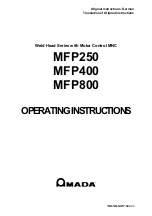
ETS 64-R
0548-990-61---70g_2019.10.indd
0548-990/62g
Page 57 of 95
Mounting and operating instructions
Function:
The first door leaf to be put in motion for the opening procedure is the Master; by means of
DubleD, this leaf is configured as MastrA. Its partner is the Slave, which is configured as SlaveA by
means of DubleD.
In the event of an existing CAN connection, the Master is identified by a small black (m) and the
Slave by a small black (s). If however there is no connection, this is indicated by a small white (m)
respectively a small white (s)
.
The parameter settings for the Master and the Slaves are entirely independent from each other. It
is thus possible to select a Vo = 4 for the Master and a Vo = 5 for the Slave.
In order to guarantee a collision-free opening of both door leaves, the Slave leaf lets the Master
leaf go ahead and initiate the opening. This time lag can be defined on the Slave by means of
AoSeq. The default value of AoSeq is 20°, which is sufficient for most of the bi-parting installa
-
tions. This means that the Slave only starts to open after the Master has exceeded an opening
angle of 20°.
From then on, it is admissible for the Slave to catch up with and pass the Master if this should be
required. This is done by configuring a higher Vo value for the Slave than the one for the Master.
In cases where (due to an electric lock connected to the Master) TDelay of the Master is config
-
ured with a higher value than 0,0 s, then the angle between the Slave and the Master is accord
-
ingly increased. To compensate this, AoSeq can be reduced in accordance.
An AoSeq value of 0° means that both door leaves will be simultaneously opened, i.e. that no
opening delay is active.
The default value of AcSeq is 20° and thus sufficient for the majority of bi-parting installations. In
cases where a mechanical closing sequence regulator is used with a mechanical closing delay of
e.g. 90°, AcSeq must be programmed with a value of 90° or more.
AcSeq 20° means: The Master only starts closing as soon as the Slave has gained a lead of 20°.
This advance guarantees that the Master will be closed in one go (without intermittence), which
results in an optically pleasing closing motion.
The Master is allowed to overtake the Slave. 20° (value AcSeq) before reaching the closed posi
-
tion, the Master checks whether the Slave is already closed. If not, the Master will perform an
intermediate stop in order to prevent a collision.
An active SES signal on a door leaf causes a safety stop of both door leaves. The same applies for
the SER signal. An active SER signal causes both door leaves to reverse their motion.
A bi-parting installation can be operated in the single-leaf mode. An active EMCY signal on the
Slave programs the closing sequence as a single-leaf configuration.
If only the EMCY signal on the Master is active, then this EMCY signal is applicable for both door
leaves. In accordance with the action configured on the Master by means of EMY-IN, both door
leaves carry out a CL-SPR (Close Spring), STOP, OPEN or CL-MOT (Close Motor).
If only the EMCY signal on the Slave is active, then the Slave carries out a CL-SPR, regardless of the
action configured on the Slave by means of EMY-IN.
If both EMCY signals are active, then the Master performs its configured EMY-IN action and the
Slave performs a CL-SPR. One exception of this rule is the Master in the EMY-IN configuration
OPEN. In this case, both door leaves will be opened.
Содержание ETS 64-R
Страница 96: ......
Страница 97: ......
Страница 98: ......
Страница 99: ......
Страница 100: ......
Страница 101: ......
Страница 102: ......
Страница 103: ......
Страница 104: ......
Страница 105: ......
Страница 106: ......
Страница 107: ......
Страница 108: ......
Страница 109: ......
Страница 110: ......
Страница 111: ......
Страница 112: ......
















































